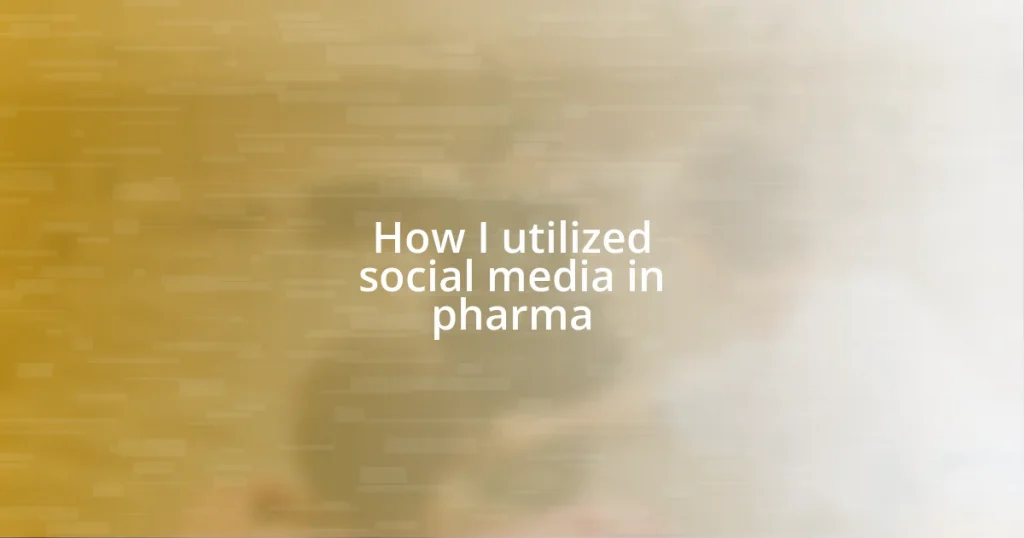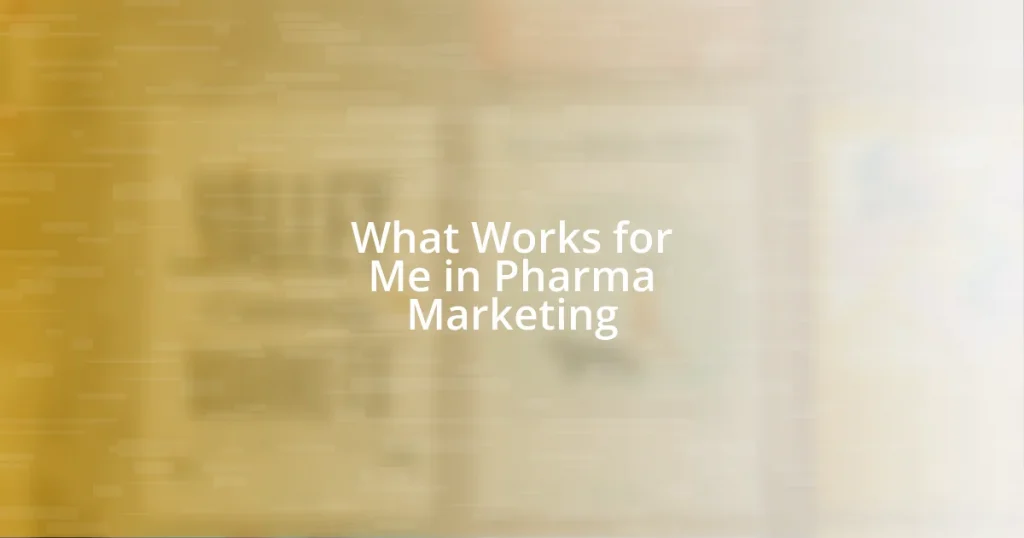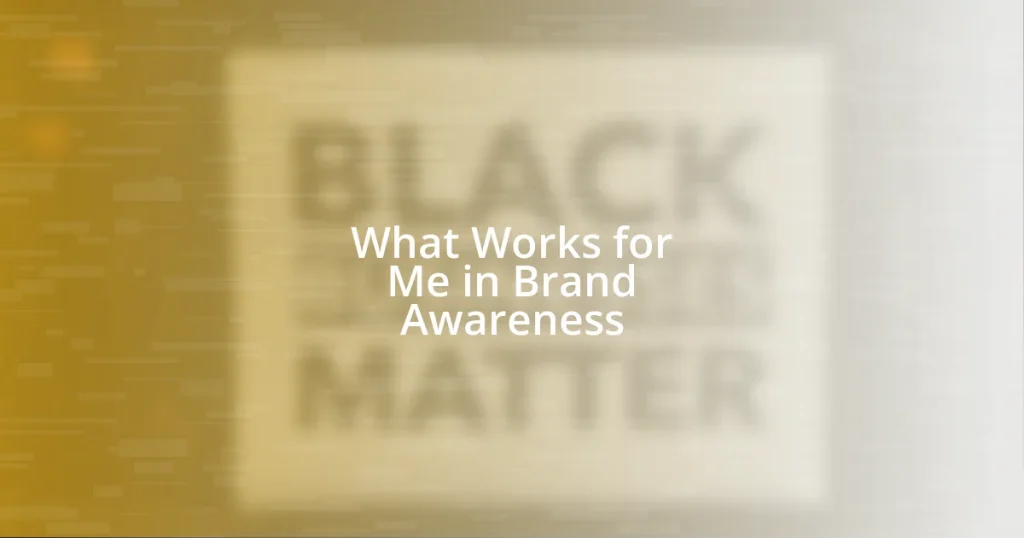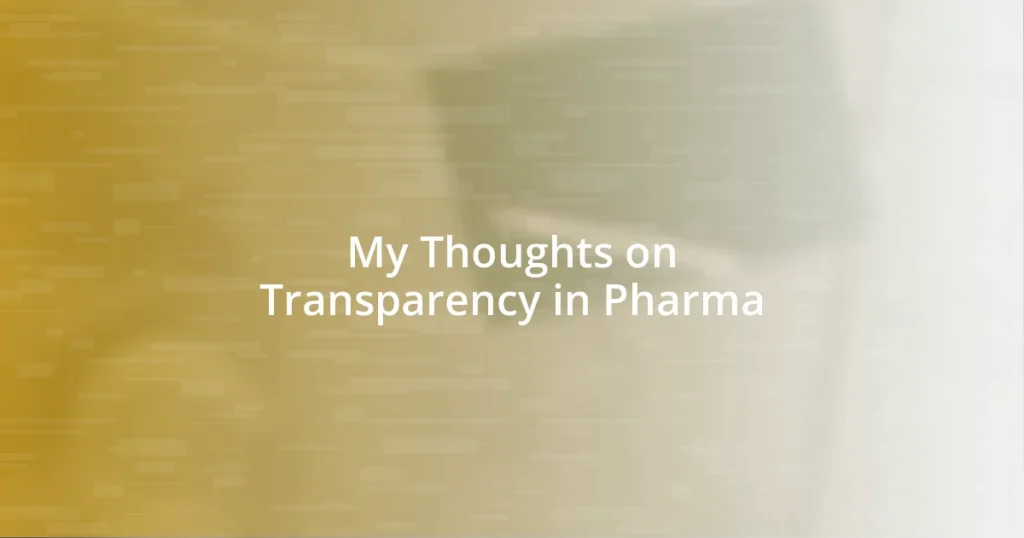Key takeaways:
- Authenticity in campaigns fosters genuine connections with audiences, illustrated by sharing relatable patient stories.
- Selecting appropriate social media platforms, like LinkedIn for professional engagement and Instagram for visual storytelling, enhances outreach and interaction.
- Compliance with regulations is essential, requiring meticulous planning and training to build trust and ensure responsible social media use in pharma.

Understanding social media in pharma
Social media in the pharmaceutical sector is a powerful tool that has transformed the way companies engage with healthcare professionals and patients alike. I remember when I first witnessed a live tweet of a medical conference, where professionals were sharing real-time insights and discussions. It struck me how social media could break down geographical barriers and foster knowledge sharing like never before.
Navigating this landscape, I’ve found that authenticity is key. One poignant example was a campaign that featured relatable stories from patients alongside educational content—seeing real faces and hearing personal journeys created a genuine connection that statistics alone simply can’t achieve. Isn’t it fascinating how a single post can spark a conversation that leads to a deeper understanding of treatments?
Moreover, compliance and regulations add a layer of complexity to the pharmaceutical use of social media. I’ve often pondered how we can strike the right balance between being informative and adhering to strict guidelines. This balancing act is crucial; it requires us to remain vigilant while fostering open communication. How can we innovate within these constraints? For me, it’s about creativity and the willingness to engage in meaningful dialogues with our audience.

Choosing the right platforms
Choosing the right social media platform is a pivotal decision in the pharmaceutical industry, and it truly hinges on understanding where your audience spends their time. I recall when my team deliberated over whether to focus on LinkedIn or Twitter for a recent campaign. LinkedIn’s professional environment allowed us to connect with healthcare professionals effectively, while Twitter’s real-time nature helped us engage with a broader audience. Ultimately, we found using both platforms enhanced our reach and produced insightful discussions.
Different platforms serve unique purposes; for instance, Instagram excels in visual storytelling, making it a fantastic choice for showcasing patient stories and behind-the-scenes looks at research. I remember a campaign we launched there that combined infographics with patient testimonials. The engagement was incredible! It reminded me of the impact visuals have in communicating complex information in a digestible way. On the other hand, Facebook’s diverse group features have made it easier to foster community discussions around specific health topics. It’s about picking the right tool for the narrative you want to share.
Understanding your goals is essential when choosing platforms. Whether you aim to raise brand awareness, build a tight-knit community, or share important updates, aligning your objectives with the platform’s strengths can make all the difference. I once set up a Facebook group for patients dealing with chronic illness, and the support and camaraderie that blossomed there were uplifting. Platforms are not just tools; they’re the channels through which relationships are built. Hence, careful selection can lead to richer interactions and stronger impacts.
| Platform | Strengths |
|---|---|
| Professional networking, B2B engagement | |
| Real-time updates, broad audience interaction | |
| Visual storytelling, strong emotional connection | |
| Community building, diverse audience discussions |

Developing a content strategy
When it comes to developing a content strategy for social media in pharma, the first step is identifying your target audience and their needs. I vividly remember brainstorming sessions with my team where we mapped out our audience’s pain points and interests. This exercise illuminated how crucial it is to create content that resonates with them, rather than just pushing information. Each post should serve a purpose, whether it’s educating, engaging, or inspiring trust.
Here are some key elements to consider when developing your content strategy:
- Audience segments: Understand various healthcare professionals and patients.
- Content types: Mix educational articles, infographics, patient stories, and videos.
- Tone and voice: Maintain a consistent, friendly, and approachable tone that reflects your brand.
- Calendaring: Develop a content calendar to schedule and plan posts efficiently.
- Performance metrics: Set clear KPIs (Key Performance Indicators) to measure the effectiveness of your content.
Creating a content strategy isn’t simply about filling a calendar with posts; it’s about weaving a narrative that connects and educates. I remember a particular moment when we shared a series of videos featuring healthcare professionals discussing less talked about side effects of a treatment. The feedback was overwhelming! Viewers felt seen and appreciated having a space to ask questions, illustrating how giving a voice to professionals can foster trust and transparency in the industry.

Engaging with healthcare professionals
Engaging healthcare professionals through social media requires a thoughtful approach. I remember hosting live Q&A sessions on LinkedIn. It was refreshing to see professionals actively participating, asking questions about our research developments. Those interactions not only humanized our brand but also built trust, crucial in an industry where transparency is paramount.
One particularly memorable instance was when a respected physician shared a critical insight during a Twitter chat we organized. His perspective resonated with many, igniting discussions that spanned hours. Isn’t it fascinating how a single conversation can spark greater awareness and collaboration among professionals? This experience solidified my belief that social media is a powerful platform for forging meaningful connections in the healthcare community.
Additionally, I’ve found that sharing relevant articles and studies on platforms like LinkedIn fosters a sense of community. When I posted about a recent clinical trial, professionals engaged not just with likes but with thoughtful comments and critiques. This dialogue reflects how social media can be more than just a promotional tool; it can serve as an essential avenue for continuous learning and sharing knowledge among healthcare experts.

Measuring campaign effectiveness
Measuring the effectiveness of a social media campaign in the pharma sector can feel daunting, but it’s truly rewarding once you see the data come to life. I can’t stress enough the importance of tracking metrics like engagement rates, click-through rates, and conversion rates. For instance, after implementing a specific call-to-action in our posts, we noticed a significant uptick in interactions, which was both exciting and validating. Isn’t it amazing how just a few simple changes can make such a difference?
I remember a campaign we ran focused on patient stories. We set clear KPIs around shares and comments, as these metrics would indicate not just reach but genuine engagement. To our delight, we saw shares exceeding our expectations, with patients and caregivers expressing their shared experiences in the comments. This not only demonstrated that our content resonated but also fostered a sense of community among those navigating similar challenges. It reinforced the idea that our efforts were making a real impact.
Another crucial aspect of measuring effectiveness is gathering qualitative feedback. I once conducted a survey following a series of educational posts, eager to hear directly from our audience. The responses were enlightening—many expressed a newfound confidence in having conversations with their healthcare providers. This personal insight was invaluable, showing that beyond numbers, our campaign was truly changing perceptions. How often do we stop to evaluate the emotional impact our campaigns have? For me, that’s where the real success lies.

Best practices for compliance
I’ve always believed that keeping abreast of regulations—like the FDA’s guidelines for promotional content—is essential when navigating social media in pharma. During one of our campaigns, we meticulously vetted each post to ensure compliance. It felt intense, but the peace of mind that came from knowing we were adhering to the rules was worth the effort. How can we effectively engage without first securing that foundation of trust through compliance?
When incorporating testimonials or patient stories, I learned firsthand the significance of obtaining proper consent. I remember a project where we highlighted a patient journey. We made it a point to document agreements meticulously, and this practice not only protected our organization but also empowered the patient by making them an integral part of our message. Isn’t it rewarding when collaboration yields such profound respect and transparency?
Lastly, I recommend regularly training your team on compliance best practices. In one session, we simulated real-life scenarios involving social media posts; the discussions revealed gaps in our understanding that we were able to address. That moment of realization emphasized that compliance isn’t just a checkbox; it’s a continuous learning process that enriches our approach to social media. After all, wouldn’t we all benefit from being a bit more informed about our responsibilities?















